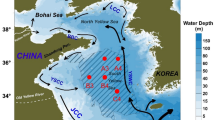Abstract
The influence of drilling fluid dispersion on the chemistry of surficial sediments was determined by an integrated study of organic and inorganic parameters. Pyrolysis characteristics and barium, organic carbon, and carbonate content were determined for sediments associated with six drilling sites in coastal Gulf of Mexico waters. The areal extent and magnitude of influence of dispersed fluids were related to water depth, prevailing currents, density of the dispersed material, history of the drill site and platform-induced biological activity. The potential use of pyrolysis techniques for defining the impact area and the various types of inputs derived from off-shore drilling operations was demonstrated.
Similar content being viewed by others
References
Barker, C., 1974, Pyrolysis techniques for source bed evaluation: Bull. Amer. Assoc. Pet. Geol., v. 58, p. 2349–2361.
Chow, T. J., J. E. Earl, J. H. Reed, N. Hansen, and V. Orphan, 1978, Barium determination by isotope dilution and neutron activation methods—a comparison of marine sediment analyses: Anal. Chem. Acta, v. 96, p. 395–399.
Chow, T. J., and C. B. Snyder, 1980, Barium in marine environment—A potential indicator of drilling contamination,in, Research on environmental fate and effects of drilling fluids and cuttings, January 21–24, 1980, Lake Buena Vista, Florida, v. 2, p. 723–738.
Dames and Moore, 1978, Drilling fluid dispersion and biological effects study for the Lower Cook Inlet C.O.S.T. well: Report for Atlantic Richfield Company.
Espitalie, J., J. L. LaPorte, M. Madec, F. Marquis, P. Leplat, J. Paulet, and A. Boutefeu, 1977, Méthode rapide de caractérization des roches meres, de leur potentiel pétrolier et de leur degré d'évolution: Rev. Inst. Fr. Pet., 32, p. 23–42.
Gettleson, D. A., and C. E. Laird, 1980, Benthic barium levels in the vicinity of six drill sites in the Gulf of Mexico,in, Research on environmental fate and effects of drilling fluids and cuttings, January 21–24, 1980, Lake Buena Vista, Florida, v. 2, p. 739–788.
Kalil, E. K., 1980, Chemical analysis of drill muds and discharge plumes,in, Research on environmental fate and effects of drilling fluids and cuttings, January 21–24, 1980, Lake Buena Vista, Florida, v. 2, p. 799–811.
McAuliffe, C. D., and L. L. Palmer, 1976, Environmental aspects of offshore disposal of drilling fluids and cuttings: California Regional Meeting of Society of Petroleum Engineers, Paper no. 5864.
McGlothlin, R. E., and H. Krause, 1980, Oil base drilling fluids,in, Research on environmental fate and effects of drilling fluids and cuttings, January 21–24, 1980, Lake Buena Vista, Florida, v. 1, p. 30–37.
McMordie, Jr., W. C., 1975. Handling and treatment of oil-base drilling muds,in, Conference proceedings on environmental aspects of chemical use in well-drilling operations, EPA-560/1-75-004; p. 505–514.
McMoride, Jr., W. C., 1980, Oil base drilling fluids,in, Research on environmental fate and effects of drilling fluids and cuttings, January 21–24, 1980, Lake Buena Vista, Florida, v. 1, p. 38–42.
Miller, K. D., 1976, A case study of special biological requirements Mustang Island Block A-16, Lease OCS-G-3011, well no. 1: Report by Cities Service Company.
Monaghan, P. H., C. D. McAuliffe, and F. T. Weiss, 1977, Environmental aspects of drilling muds and cuttings from oil and gas extraction operations in offshore and coastal waters: Offshore Technology Conf., Paper no. 2755.
Offshore Operators Committee, 1978, Comments on U.S. Environmental Protection Agency draft document, “Permit conditions NPDES permits at the Flower Garden Reefs, Gulf of Mexico, outer continental shelf, August, 1978”: Submitted to U.S. EPA Region VI.
Perricone, C., 1980, Major drilling fluid additives 1979,in, Research on environmental fate and effects of drilling fluids and cuttings, January 21–24, 1980, Lake Buena Vista, Florida. v. 1, p. 15–29.
Rubinstein, N. I., R. Rigby, and C. N. D'Asaro, 1980, Acute and sublethal effects of whole used drilling fluids on representative estuarine organisms,in, Research on environmental fate and effects of drilling fluids and cuttings, January 21–24, 1980, Lake Buena Vista, Florida, v. 2, p. 828–846.
Shinn, E. A., 1975, Effects of oil field brine, drilling mud cuttings and oil platforms on the offshore environment,in, Marine environmental implications of offshore oil and gas development in the Baltimore Canyon region of the Mid-Atlantic Coast Estuarine Research Foundation 75-1. p. 243–255.
Tagatz, M. E., J. M. Ivey, H. K. Lehman, and M. Tobia, 1980, Effects of drilling mud on the development of experimental estuarine macrobenthic communities,in, Research on environmental fate and effects of drilling fluids and cuttings, January 21–24, 1980, Lake Buena Vista, Florida, v. 2, p. 847–865.
Weshaw, R. L., and G. E. Bohner, 1969, Pyrolysis of humic and fulvic acids: Geochim. Cosmochim. Acta, v. 33, p. 757–762.
Whelan, J. K., J. M. Hunt, and A. Y. Huc, 1980, Applications of thermal distillation-pyrolysis to petroleum source rock studies and marine pollution: J Analytical and Applied Pyrolysis, 2, p. 79–96.
World Oil, 1977, World Oil's 1977–78 guide to drilling, workover, and completion fluids: Gulf Publ. Co.
Zingula, R. P., and D. W. Larsen, 1977, Fate of drill cuttings in the marine environment: Offshore technology conference, Paper no. 3040, 553–556.
Author information
Authors and Affiliations
Rights and permissions
About this article
Cite this article
Kennicutt, M.C., Keeney-Kennicutt, W.L., Bresley, B.J. et al. The use of pyrolysis and barium distributions to assess the areal extent of drilling fluids in surficial marine sediments. Geo 4, 239–249 (1982). https://doi.org/10.1007/BF02380517
Issue Date:
DOI: https://doi.org/10.1007/BF02380517




